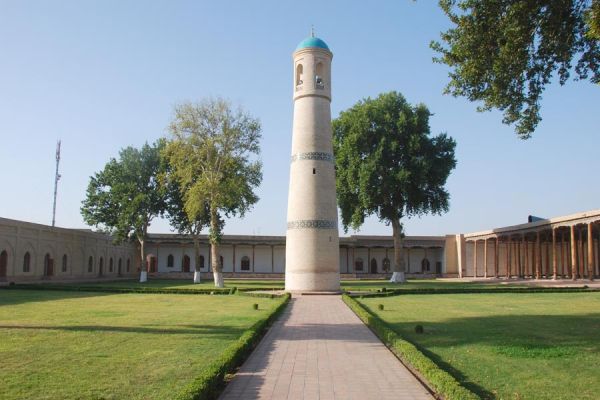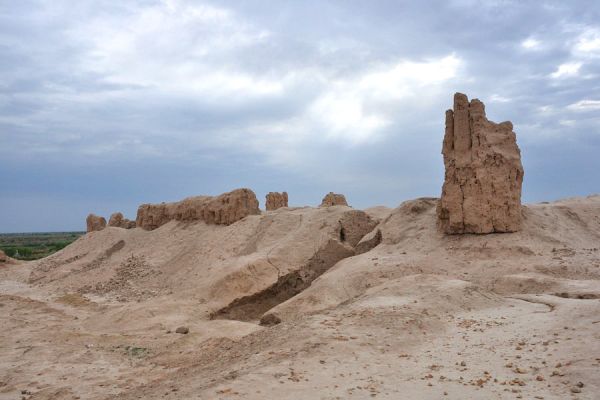Jami Mosque in Kokand
In the 18th and 19th centuries, when Kokand became the center of a large and powerful state, many large and beautiful mosques were built in the city. It is known from written sources that there were 230 quarterly and 18 Friday mosques in the capital of the Kokand Khanate.
The construction of the Jami Mosque, the grandest mosque in the city, was completed in 1818. However, the history of its construction began back in the XVIII century, when, at the behest of the ruler of Kokand, Alim Khan, the construction of the Jami madrasah for 100 hujras was begun, and with it this magnificent cathedral mosque. According to a legend among the locals, the logs for the pillars supporting the ceiling of her ivan were sent by the famous poet Zebinisso, who was Babur's great-granddaughter and lived in India. However, after the assassination of Alim Khan by the conspirators, construction had to be interrupted, and the bricks were used to restore the old Kokand Urda. And only in 1817, on the instructions of Umar Khan, the construction of the mosque began anew.
As they say, before laying the first brick, and this was traditionally done by the most righteous and God-fearing man, Umar Khan addressed the audience three times with the question: "Is there a man among you who has not committed a single sin in his life?" And since there was silence in response, he, considering himself the most sinless, laid the first stone in the walls of the mosque himself. After that, Umar Khan became known by the nickname "Zhannat makon", that is, "worthy of paradise, beloved of the gods."
The main cathedral mosque of Kokand is a khanaka, a winter room surrounded on three sides by an aivan. The vault of the ivan is supported by ninety-eight columns made of a hard variety of elm, which is called "stone wood". Ten similar columns are located inside the khanaka. All of them are beautifully carved, topped with stalactite capitals and mounted on marble bases. The main facade of the mosque, about a hundred meters long, faces east, is highlighted by a colonnade and decorated with a decorative cornice, which is raised above the central entrance, forming the so-called kayvan. In contrast to the simple brickwork of the exterior walls, the main facade and interior of the mosque are richly decorated. The ceiling plafonds and beams, made in the "vassa juft" style typical of the Fergana Valley, are painted with geometric and floral patterns. The walls are decorated with rectangular and pointed panels made of carved ganch, the panels are decorated with ornaments in the traditional Kokand technique "chaspak" – a kind of mosaic made of colored ganch.
In 1852, during the reign of Khudoyar Khan, a burnt brick minaret with a height of almost twenty-two meters was built next to the Jami Mosque. It has the shape of a truncated cone with a hexagonal lantern at the top. There is a spiral staircase inside the trunk, along which the azanchi ascended five times a day to call the faithful to prayer. Five years after the construction of the minaret, Khudoyar Khan invited the best craftsmen and artists to restore the cathedral mosque. For this purpose, he ordered the use of two years of income from the waqf – lands designated for the maintenance of mosques and madrassas.
After the annexation of the Kokand Khanate to Russia, in 1905, the Jami mosque was renovated, which had become quite dilapidated by that time. The funds for this charitable cause were allocated by the local rich merchant Mir Habib-bai. Stonemasons were invited from Armenia, and other craftsmen came from all over the Ferghana Valley. Some of them were not very experienced, so the magnificent murals were painted over with an inept hand.
Under Soviet rule, the madrasah was dismantled into bricks, the Jami Mosque was closed, and the main facade was bricked up. It was only in 1982 that the mosque was thoroughly renovated. The rotten bases of the wooden columns were replaced and, most importantly, the unique ornamental painting of the ivan and the interior were restored to its former form. Today, the mosque has been returned to the faithful and, as of old, the townspeople flock here on Fridays to pray.















